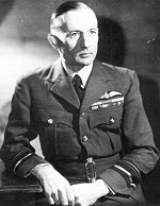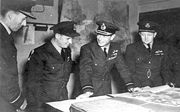
Ralph Cochrane
Encyclopedia
Air Chief Marshal
Sir Ralph Alexander Cochrane, GBE
, KCB
, AFC
, RAF
(24 February 1895–17 December 1977) was a British
pilot
and Royal Air Force
officer, perhaps best known for his role in Operation Chastise
, the famous "Dambusters" raid.
village of Springfield
. Although not certain, it is likely that he attended the Royal Naval College at Osborne
in 1908. On 15 September 1912, Cochrane entered the Royal Navy
proper as a midshipman
.
During the First World War, Cochrane served in the Royal Naval Air Service
piloting airships. He also completed a tour as a staff officer in the Admiralty
's Airship Department.
In January 1920, he was removed from the Navy List and granted a commission in the Royal Air Force. Between the Wars, Cochrane served in various staff positions and commanded No. 3 Squadron
from 1924 before attending the RAF Staff College commanding and No. 8 Squadron from 1929. He attended the Imperial Defence College
in 1935.
In 1936 Cochrane was sent to New Zealand to assist with the establishment of the Royal New Zealand Air Force
as an independent service from the Army. On 1 April 1937, Cochrane was appointed Chief of the Air Staff of the Royal New Zealand Air Force.

from July 1940, No. 3 Group
from September 1942 and No. 5 Group
from February 1943; all these Groups were in RAF Bomber Command
. 5 Group became the most efficient and elite Main Force bomber group undertaking spectacular raids. Cochrane commanded the Dam-Busters raid. There was intense, sometimes openly hostile, rivalry between Cochrane and Air Vice Marshal Donald Bennett, who saw Cochrane's experimentation with low-level target marking in 1944 as a direct threat to his own specialist squadron's reputation.
In February 1945, Cochrane became Air Officer Commanding at RAF Transport Command
, a position he held until 1947 when he became Air Officer Commanding at RAF Flying Training Command
. During this time he managed the Berlin Airlift. In 1950 Cochrane was appointed Vice-Chief of the Air Staff
. Ralph Cochrane retired from the service in 1952. Following his retirement, Cochrane entered the business world notably as director of Rolls Royce. He was also chairman of RJM exports which manufactured scientific models and is now known as Cochranes of Oxford.
Air Chief Marshal
Air chief marshal is a senior 4-star air-officer rank which originated in and continues to be used by the Royal Air Force...
Sir Ralph Alexander Cochrane, GBE
Order of the British Empire
The Most Excellent Order of the British Empire is an order of chivalry established on 4 June 1917 by George V of the United Kingdom. The Order comprises five classes in civil and military divisions...
, KCB
Order of the Bath
The Most Honourable Order of the Bath is a British order of chivalry founded by George I on 18 May 1725. The name derives from the elaborate mediæval ceremony for creating a knight, which involved bathing as one of its elements. The knights so created were known as Knights of the Bath...
, AFC
Air Force Cross (United Kingdom)
The Air Force Cross is a military decoration awarded to personnel of the United Kingdom Armed Forces, and formerly also to officers of the other Commonwealth countries, for "an act or acts of valour, courage or devotion to duty whilst flying, though not in active operations against the enemy"...
, RAF
Royal Air Force
The Royal Air Force is the aerial warfare service branch of the British Armed Forces. Formed on 1 April 1918, it is the oldest independent air force in the world...
(24 February 1895–17 December 1977) was a British
United Kingdom
The United Kingdom of Great Britain and Northern IrelandIn the United Kingdom and Dependencies, other languages have been officially recognised as legitimate autochthonous languages under the European Charter for Regional or Minority Languages...
pilot
Aviator
An aviator is a person who flies an aircraft. The first recorded use of the term was in 1887, as a variation of 'aviation', from the Latin avis , coined in 1863 by G. de la Landelle in Aviation Ou Navigation Aérienne...
and Royal Air Force
Royal Air Force
The Royal Air Force is the aerial warfare service branch of the British Armed Forces. Formed on 1 April 1918, it is the oldest independent air force in the world...
officer, perhaps best known for his role in Operation Chastise
Operation Chastise
Operation Chastise was an attack on German dams carried out on 16–17 May 1943 by Royal Air Force No. 617 Squadron, subsequently known as the "Dambusters", using a specially developed "bouncing bomb" invented and developed by Barnes Wallis...
, the famous "Dambusters" raid.
Early RAF career
Ralph Cochrane was born on 24 February 1895, the youngest son of Thomas Cochrane, 1st Baron Cochrane of Cults, in the ScottishScotland
Scotland is a country that is part of the United Kingdom. Occupying the northern third of the island of Great Britain, it shares a border with England to the south and is bounded by the North Sea to the east, the Atlantic Ocean to the north and west, and the North Channel and Irish Sea to the...
village of Springfield
Springfield, Fife
The small village of Springfield lies at the edge of the Howe of Fife, to the south of the town of Cupar, Fife, Scotland. The origin of the community is thought to be from the linen industry in the 19th century. The Church of Scotland parish church was built in 1861...
. Although not certain, it is likely that he attended the Royal Naval College at Osborne
Osborne House
Osborne House is a former royal residence in East Cowes, Isle of Wight, UK. The house was built between 1845 and 1851 for Queen Victoria and Prince Albert as a summer home and rural retreat....
in 1908. On 15 September 1912, Cochrane entered the Royal Navy
Royal Navy
The Royal Navy is the naval warfare service branch of the British Armed Forces. Founded in the 16th century, it is the oldest service branch and is known as the Senior Service...
proper as a midshipman
Midshipman
A midshipman is an officer cadet, or a commissioned officer of the lowest rank, in the Royal Navy, United States Navy, and many Commonwealth navies. Commonwealth countries which use the rank include Australia, New Zealand, South Africa, India, Pakistan, Singapore, Sri Lanka and Kenya...
.
During the First World War, Cochrane served in the Royal Naval Air Service
Royal Naval Air Service
The Royal Naval Air Service or RNAS was the air arm of the Royal Navy until near the end of the First World War, when it merged with the British Army's Royal Flying Corps to form a new service , the Royal Air Force...
piloting airships. He also completed a tour as a staff officer in the Admiralty
Admiralty
The Admiralty was formerly the authority in the Kingdom of England, and later in the United Kingdom, responsible for the command of the Royal Navy...
's Airship Department.
In January 1920, he was removed from the Navy List and granted a commission in the Royal Air Force. Between the Wars, Cochrane served in various staff positions and commanded No. 3 Squadron
No. 3 Squadron RAF
No 3 Squadron of the Royal Air Force operates the Typhoon F2, FGR4 and T3 from RAF Coningsby, Lincolnshire.No 3 Squadron, which celebrated its 95th anniversary over the weekend of 11-13 May 2007, is unique in the RAF for having two official crests....
from 1924 before attending the RAF Staff College commanding and No. 8 Squadron from 1929. He attended the Imperial Defence College
Royal College of Defence Studies
The Royal College of Defence Studies is an internationally-renowned institution and component of the Defence Academy of the United Kingdom...
in 1935.
In 1936 Cochrane was sent to New Zealand to assist with the establishment of the Royal New Zealand Air Force
Royal New Zealand Air Force
The Royal New Zealand Air Force is the air arm of the New Zealand Defence Force...
as an independent service from the Army. On 1 April 1937, Cochrane was appointed Chief of the Air Staff of the Royal New Zealand Air Force.

World War II and the post-war years
During the Second World War, Cochrane commanded No. 7 GroupNo. 7 Group RAF
Number 7 Group of the Royal Air Force was an RAF group active in the latter part of World War I, during the 1920s and also in World War II.-Organizational history:...
from July 1940, No. 3 Group
No. 3 Group RAF
Number 3 Group of the Royal Air Force was an RAF group first active in 1918, again in 1923-26, part of RAF Bomber Command from 1936 to 1967, and part of RAF Strike Command from 2000 until it disbanded on 1 April 2006.-The 1930s and World War II:...
from September 1942 and No. 5 Group
No. 5 Group RAF
No. 5 Group was a Royal Air Force bomber group of the Second World War, led during the latter part by AVM Sir Ralph Cochrane.-History:The Group was formed on 1 September 1937 with headquarters at RAF Mildenhall....
from February 1943; all these Groups were in RAF Bomber Command
RAF Bomber Command
RAF Bomber Command controlled the RAF's bomber forces from 1936 to 1968. During World War II the command destroyed a significant proportion of Nazi Germany's industries and many German cities, and in the 1960s stood at the peak of its postwar military power with the V bombers and a supplemental...
. 5 Group became the most efficient and elite Main Force bomber group undertaking spectacular raids. Cochrane commanded the Dam-Busters raid. There was intense, sometimes openly hostile, rivalry between Cochrane and Air Vice Marshal Donald Bennett, who saw Cochrane's experimentation with low-level target marking in 1944 as a direct threat to his own specialist squadron's reputation.
In February 1945, Cochrane became Air Officer Commanding at RAF Transport Command
RAF Transport Command
RAF Transport Command was a Royal Air Force command that controlled all transport aircraft of the RAF. It was established on 25 March 1943 by the renaming of the RAF Ferry Command, and was subsequently renamed RAF Air Support Command in 1967.-History:...
, a position he held until 1947 when he became Air Officer Commanding at RAF Flying Training Command
RAF Flying Training Command
Flying Training Command was an organization within the Royal Air Force which controlled units responsible for delivering flying training. The command's headquarters were at Shinfield Park, Reading in Berkshire.-History:...
. During this time he managed the Berlin Airlift. In 1950 Cochrane was appointed Vice-Chief of the Air Staff
Vice-Chief of the Air Staff (United Kingdom)
The British Vice-Chief of the Air Staff was the post occupied by the senior Royal Air Force officer who served as a senior assistant to the Chief of the Air Staff. The post was created during World War II on 22 April 1940 and its incumbement sat on the Air Council...
. Ralph Cochrane retired from the service in 1952. Following his retirement, Cochrane entered the business world notably as director of Rolls Royce. He was also chairman of RJM exports which manufactured scientific models and is now known as Cochranes of Oxford.

